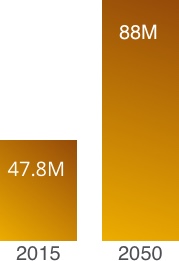IMPACT
California is failing its older adults. The state’s workforce and related long-term services are not keeping up with our aging population.
The Problem
- Los Angeles
- San Francisco
- San Diego
- Sacramento
Los Angeles
-
Rapid Growing Population
15% of Los Angeles County’s population is over 65 years old. By 2050, the percentage will double to 30%.
-
Poverty
13.2% of older adults live below the federal poverty level.
-
Housing
80% of low-income seniors are rent-burdened. The number of homeless age 62 or older rose 22% in 2018, even as the overall homeless population has slightly dropped.
San Francisco
-
Rapid Growing Population
19% of San Francisco County’s population is over 65 years old. By 2050, the percentage will jump to 31%.
-
Poverty
13.4% of seniors live below the federal poverty level.
-
Housing
69.7% of low-income seniors are rent-burdened.
San Diego
-
Rapid Growing Population
16% of San Diego County’s population is over 65 years old. By 2050, the percentage will jump to 26%.
-
Poverty
8.6% of seniors live below the federal poverty level.
-
Housing
75.2% of seniors are rent-burdened.
Sacramento
-
Rapid Growing Population
16% of Sacramento County's population is over 65 years old. By 2050, the percentage will jump to 24%.
-
Poverty
9.8% of older adults live below the federal poverty level.
-
Housing
85.2% of low-income seniors are rent-burdened.
California's Aging Population
is Heading for a Crisis
California needs to ensure that seniors have access to long-term services and caregiver supports.
A Rapidly Growing Older Population
The population of older adults age 65 and older will increase from 47.8 million in 2015 to 88 million in 2050.

A Growing Need for Workers
The nation will need 2.5 million long-term services and supports workers by 2030 to keep up with growth of America’s aging population.

Get to know the facts:
150%
Increase in 85yr-olds in 65+ of California’s counties
88%
Increase in older adults with self-care limitations from 2012-2030
76%
Baby Boomers have saved less than $100,000
50%
Less than 50% of older adult households have retirement income
87%
California’s older adult population will increase 87% by 2030
54%
Demand for healthcare workforce will increase by 54% by 2020
29%
29% of California's older adults live at 200% of poverty level or $24,000/yr
80%
Increase in demand of aging related health care through 2020
Californians lack access to vital long-term services and supports
Today, one in five Californians over the age of 65 lives in poverty. With the population of older adults growing twice as fast as the state’s total population, the problem is only going to get worse.
The state’s high cost of living, lack of affordable housing and shortfall of caregivers mean that even middle-class older adults are struggling to afford retirement. Yet, most people are unaware of the costs and duration of need of long-term services and supports.

Californians need access to respectful care that preserves their dignity at all stages of life.
THE SOLUTION
California needs a master plan for aging that prepares us for the oncoming aging crisis and ensures older adults have access to long-term services and supports.
Master Plan for Aging
Californians must join together and hold elected officials accountable for creating a Master Plan for Aging that prepares the state for the looming aging crisis and ensures that older adults can access the care they desperately need to thrive. By working to build the Master Plan for Aging, the state will chart a path forward that provides all Californians with the opportunity to age with dignity.
Long-term Services and Supports
Californians lack access to vital long-term services and supports. According to the Kaiser Family Foundation, 70% of baby boomers can expect to need some form of long-term care – from help bathing and getting dressed to grocery shopping and fixing meals – in their lifetime. California must provide financial assistance to support access to these vital services before older adults become impoverished and alone.
Workforce Development
California faces a looming caregiver workforce crisis. The Employment Development Department projects that the state will need 40% more caregivers by 2026. We must create workforce solutions ensuring that we have enough care professionals to support the state’s growing aging population. The demand for a workforce to serve aging Californians will only rise.
Will you take a stand to protect California's seniors?
PLEDGE TODAY
Sign the pledge to ensure California's older adults have access to long-term services and supports.
I support aging Californians.
The state is unprepared for the looming aging crisis. The status quo is unacceptable – it’s time for a change.
I call on our elected officials to ensure our growing population of older adults has access to long-term services and supports.
I pledge to help California #AgeOnRageOn.